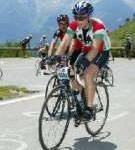We’re now 10 weeks in to the Polarised Training Challenge and I think it’s time to take stock of what we have achieved in performance terms.
The table below summarises performance at two recent ‘test’ events:

Both of these are 100 mile (approx) cyclo sportive events that I rode as hard as I reasonably could following a taper week. For both events I got my nutrition tactics wrong, so that due to not eating enough I felt quite tired towards the end of the event and was not able to maintain the same speed as I had done earlier (although the perceived effort level was fairly constant throughout the event in both cases).
What stands out to me is that on every metric, my performance in the second event was better than in the first, especially my average speed considering the amount of climbing (both events are regarded as hilly!).
My heart rate variability (HRV) scores were also higher for the second event – both the actual score on the morning of the event and the baseline moving average of the previous 7 days (the blue line on the ithlete HRV chart). I would place some caution on taking race day HRV measures too literally, since the combination of race day nerves and perhaps an early start could bias these either in a negative (nerves) or positive (early rise) way, hence the baseline might be a better indicator when assessing the actual performance relative to underlying HRV.
Despite the earlier comments about nutrition, I’m pretty pleased with these two results, getting 11th & 8th best times in my age group respectively. So far I think that the polarised training is working for me, and I am also seeing early confirmation of the research by Chalencon and Buchheit we summarised where higher HRV predicts better performance.
The next real test will the Dragon Ride in Wales on June 9th, which is a bigger scale of challenge than either of these two events!

